选煤厂介耗分析__本科毕设论文
重介选煤厂介耗的分析及对策

论文题目:重介选煤厂介质损耗的分析及对策申报人:所属单位:申报专业:申报时间:重介选煤厂介质损耗的分析及对策在重介选煤过程中,重介悬浮液加重质(磁铁矿粉)的损耗是避免不了的。
而介质损耗一直是重介选煤厂一项重要的技术评价指标。
通常分选块煤的介耗要比分选末煤时低,用低密度悬浮液时比用高密度悬浮液时低。
按选煤厂设计规范规定,吨原煤介质损耗指标是:块煤系统为0.2~0.3kg,末煤系统为0.5~1.0k g。
事实上,选煤厂极少有能达到上述指标的。
目前,吨原煤介质损耗较先进的指标在1.5kg左右,一般在2~3kg,高的在5~6kg。
因此,对重介选煤厂影响介质损耗因素进行系统分析十分必要。
选煤厂介质损耗高时,一方面可能是因煤质变化较大而使原设计的系统不相匹配或设计存在缺陷;另一方面可能是生产管理问题,这就需要在生产中进行有效管理,减少管理损失,控制技术损失。
一、影响介耗的因素及对策选煤厂介质损耗(简称:介耗)常规分为管理损失和技术损失两方面。
管理损失一般较直观,主要表现在跑、冒、滴、漏、事故放料、储运等流失的介质;而技术损失影响因素比较复杂,各厂因工艺不同而有所不同。
技术损失主要表现在最终产品带介和磁选尾矿流失两方面。
要减少实际介耗的损失量,必须对影响介耗的因素进行分析、排查并进行治理。
1、磁铁矿粉质量有的选煤厂存在介质技术损失并不大、但介耗却很高的情况,原因可能是由于磁铁矿粉质量没有达到要求。
因为加重质粒度越细,重悬浮液密度也越稳定,在重悬浮液中为起稳定作用而掺入的煤泥量也相应减少;加重质粒度变粗后,重悬浮液稳定性变差,为了满足稳定性的要求势必要加大泥质物含量,从而导致脱介筛和分选机效率下降,加重质损失明显增大。
故我国设计规范规定,用磁铁矿粉作加重质时,密度须在4.5g/cm 3左右。
对加重质磁性物含量的要求是:磁铁矿粉磁性物含量需达到90%以上。
对加重质粒度含量要求是分选块煤时,-0.074mm粒度含量必须达到规定的80%以上;分选末煤时,-0.044mm粒度含量必须达到90%以上。
选煤厂的介耗控制研究
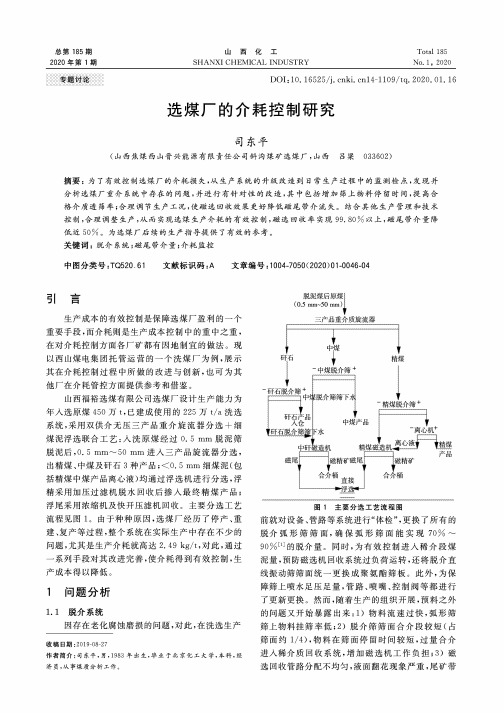
矿中的磁性物含量,即占磁选尾矿百分数,% O 通过试验检测,得表1结果。 表1磁选工艺效果评定表
稀介磁含量/% 精矿磁含量/% 尾矿磁含量/% 磁性物回收率/% 煤泥脱除率/%
1 48.397 77.026 0. 489 99. 62 71. 25
2 48.397 77.026 0. 252 99. 81 71.89
磁选机是介质回收的主要设备,磁选机的工艺 效果好坏直接影响生产整个重介质系统的稳定 ,而 磁选效率的高低直接影响生产介耗的多少,目前选
煤用磁选机效率一般在99%左右,仍有约1%的重 介质通过磁尾流失⑵。为此,参考《MT/T816 2011选煤磁选设备工艺效果评定方法》对现有磁选 机(美国艺利HMDA-6型湿式磁选机)进行检测,其 效果评定指标为:1)磁性物回收率S即磁选机的精 矿中所回收的磁性物占入料磁性物的百分比值;2) 煤泥脱除率e0,即磁选机的尾矿中排出的非磁性物 占入料的非磁性物的百分比值。
1问题分析
关于王庄煤矿选煤厂降低介耗的探讨
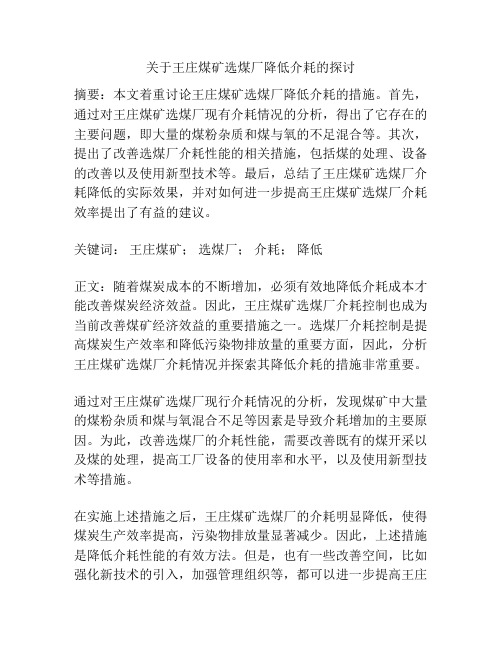
关于王庄煤矿选煤厂降低介耗的探讨摘要:本文着重讨论王庄煤矿选煤厂降低介耗的措施。
首先,通过对王庄煤矿选煤厂现有介耗情况的分析,得出了它存在的主要问题,即大量的煤粉杂质和煤与氧的不足混合等。
其次,提出了改善选煤厂介耗性能的相关措施,包括煤的处理、设备的改善以及使用新型技术等。
最后,总结了王庄煤矿选煤厂介耗降低的实际效果,并对如何进一步提高王庄煤矿选煤厂介耗效率提出了有益的建议。
关键词:王庄煤矿;选煤厂;介耗;降低正文:随着煤炭成本的不断增加,必须有效地降低介耗成本才能改善煤炭经济效益。
因此,王庄煤矿选煤厂介耗控制也成为当前改善煤矿经济效益的重要措施之一。
选煤厂介耗控制是提高煤炭生产效率和降低污染物排放量的重要方面,因此,分析王庄煤矿选煤厂介耗情况并探索其降低介耗的措施非常重要。
通过对王庄煤矿选煤厂现行介耗情况的分析,发现煤矿中大量的煤粉杂质和煤与氧混合不足等因素是导致介耗增加的主要原因。
为此,改善选煤厂的介耗性能,需要改善既有的煤开采以及煤的处理,提高工厂设备的使用率和水平,以及使用新型技术等措施。
在实施上述措施之后,王庄煤矿选煤厂的介耗明显降低,使得煤炭生产效率提高,污染物排放量显著减少。
因此,上述措施是降低介耗性能的有效方法。
但是,也有一些改善空间,比如强化新技术的引入,加强管理组织等,都可以进一步提高王庄煤矿选煤厂介耗效率。
综上所述,选煤厂介耗降低是提高产量和降低污染物排放量的重要措施,王庄煤矿选煤厂实施妥善的措施可以有效降低介耗。
同时,还应加强新技术的引入,进一步提高王庄煤矿选煤厂介耗效率。
在实施降低介耗措施时,要注意在技术可行性方面给予充分的考虑。
首先,针对技术要考虑设备的质量、运行稳定性及能耗以及维护保养成本等。
其次,要注意技术的安全性,以便保证合理的安装和使用。
此外,还应考虑技术的经济效益,即降介耗是经济可行的,并需要考虑技术的发展前景,以确保介耗降低的效果能够持续。
此外,在降低介耗过程中,运用科学的管理方法也是非常必要的。
选煤厂介质消耗因素分析研究
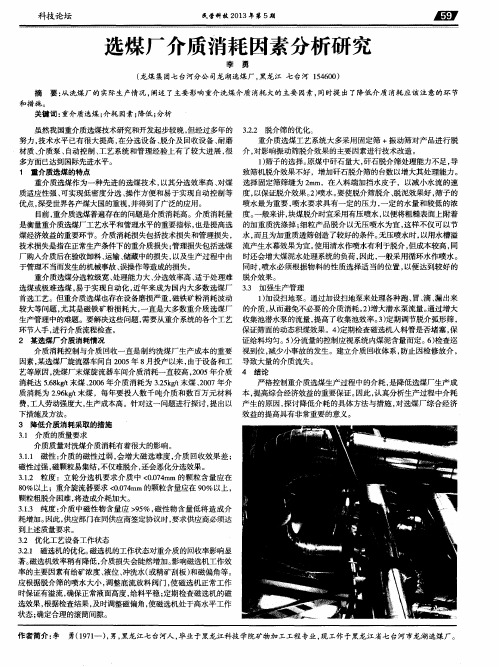
民营 科技2 0 1 3 年第5 期
选煤厂介质消耗 因素分析研究
李 勇
( 龙 煤 集 团七 台河 分 公 司龙 湖 选 煤 厂 , 黑 龙 江 七 台河 1 5 4 6 0 0 )
摘
要: 从洗煤厂的实际生产情 况, 阐述 了主要 影响重介 洗煤介质消耗 大的主要 因素 , 同时提 出了降低介 质消耗应该 注意的环节
民营科技2013年第5期科技论坛选煤厂介质消耗因素分析研究李勇龙煤集团七台河分公司龙湖选煤厂黑龙江七台河154600虽然我国重介质选煤技术研究和开发起步较晚但经过多年的努力技术水平已有很大提高在分选设备脱介及回收设备耐磨材质介质泵自动控制工艺系统和管理经验上有了较大进展很多方面已达到国际先进水平
科技论坛
于管理不 当而发生的机械事故 、 误操作等造成的损失。 重介质选煤7 . 1 J e .  ̄ 粒级宽 、 处理能力大、 分选效率高 、 适于处理难 选煤或极难选煤 , 易于实现 自动化 , 近年来成为 国内大多数选煤厂 首选工艺 。但重介质选煤也存在设备磨损严重 , 磁铁矿粉消耗波动 较大等问题 , 尤其是磁铁矿粉损耗大 , 一 直是大多数重介质 重介质选煤 ; 介耗 因素; 降低 ; 分析 虽然我国重介质选煤技术研究和开发起步较晚 , 但经过多年的 3 . 2 . 2 脱介筛的优化 。 努力 , 技术水平 已有很 大提高 , 在分选设备 、 脱介及 回收设 备、 耐磨 重介 质选煤工艺系统 大多采用 固定筛 +振 动筛对产 品进行脱 材质 、 介质泵 、 自动控制 、 工艺系统和管理经验上有了较大进展 , 很 介 , 对影响振动筛脱介效果 的主要因素进行技术改造。 多方面已达到国际先进水平。 1 ) 筛子的选择 。 原煤 中矸石量大 , 矸石脱介筛处理能力不足 , 导 致筛机脱介效果不好 ,增加矸石脱介筛的台数以增大其处理能力。 1 重介质选煤的特点
选煤厂降低介耗的研究与实践
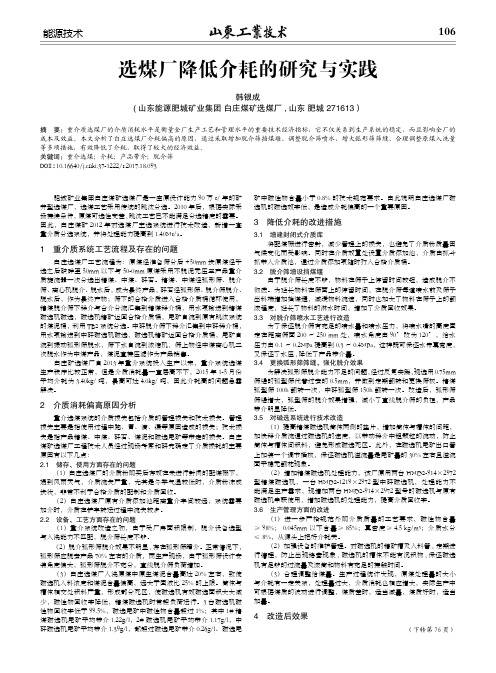
肥城矿业集团白庄煤矿选煤厂是一座原设计能力90万t/年的矿井型选煤厂,选煤工艺采用传统的跳汰分选。
2010年后,根据实际采场接续条件,原煤可选性变差,跳汰工艺已不能满足分选精度的需要。
因此,白庄煤矿2012年对选煤厂主选系统进行技术改造,新增一套重介质分选系统,并将处理能力提高到1.40Mt/a。
1 重介质系统工艺流程及存在的问题 白庄选煤厂工艺流程为:原煤经准备筛分后+50mm块原煤经手选之后破碎至50mm以下与50-0mm原煤采用不脱泥无压三产品重介质旋流器一次分选出精煤、中煤、矸石。
精煤、中煤经弧形筛、脱介筛、离心机脱介、脱水后,成为最终产品,矸石经弧形筛、脱介筛脱介、脱水后,作为最终产物;筛下的合格介质进入合格介质桶循环使用,精煤脱介筛下稀介与合介分流汇集到精煤稀介桶,用水泵输送到精煤磁选机磁选,磁选机精矿返回合格介质桶,尾矿自流到原有跳汰系统的煤泥桶,利用TBS系统分选。
中矸脱介筛下稀介汇集到中矸稀介桶,用水泵输送到中矸磁选机磁选,磁选机精矿返回合格介质桶,尾矿自流到振动弧形筛脱水,筛下水自流到浓缩机,筛上物经中煤离心机二次脱水作为中煤产品,煤泥直接压滤作为产品销售。
白庄矿选煤厂自2013年重介系统投入生产以来,重介系统选煤生产秩序比较正常,但是介质消耗量一直居高不下,2015年1-5月份平均介耗为3.40kg/吨,最高可达4.0kg/吨,因此介耗高的问题急需解决。
2 介质消耗偏高原因分析 重介选煤系统的介质损失包括介质的管理损失和技术损失。
管理损失主要是指使用过程中跑、冒、滴、漏等原因造成的损失;技术损失是指产品精煤、中煤、矸石、煤泥和磁选尾矿等带走的损失。
白庄煤矿选煤厂工程技术人员经过现场考察和研究确定了介质损耗的主要原因有以下几点:2.1 储存、使用方面存在的问题 (1)白庄选煤厂的介质粉购买后存放在未进行封闭的配煤棚下,遇到风雨天气,介质流失严重,尤其是冬季气温较低时,介质粉冻成块状,非常不利于合格介质的配制和介质回收。
选煤厂降低介耗的方法研究
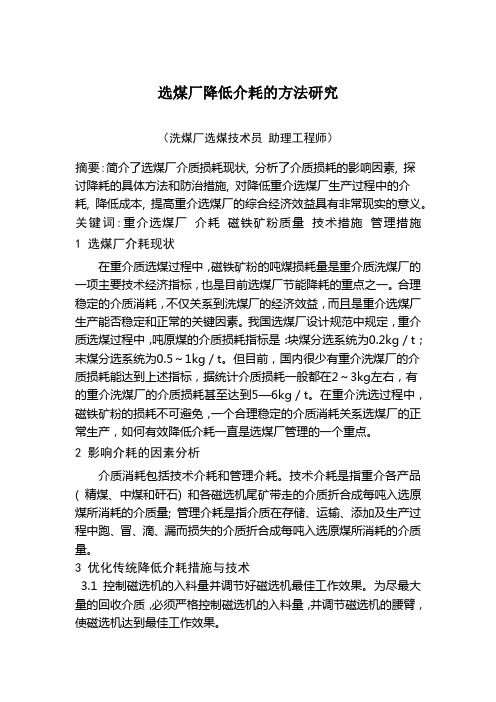
选煤厂降低介耗的方法研究(洗煤厂选煤技术员助理工程师)摘要:简介了选煤厂介质损耗现状, 分析了介质损耗的影响因素,探讨降耗的具体方法和防治措施, 对降低重介选煤厂生产过程中的介耗, 降低成本, 提高重介选煤厂的综合经济效益具有非常现实的意义。
关键词:重介选煤厂介耗磁铁矿粉质量技术措施管理措施1 选煤厂介耗现状在重介质选煤过程中,磁铁矿粉的吨煤损耗量是重介质洗煤厂的一项主要技术经济指标,也是目前选煤厂节能降耗的重点之一。
合理稳定的介质消耗,不仅关系到洗煤厂的经济效益,而且是重介选煤厂生产能否稳定和正常的关键因素。
我国选煤厂设计规范中规定,重介质选煤过程中,吨原煤的介质损耗指标是:块煤分选系统为0.2kg/t;末煤分选系统为0.5~1kg/t。
但目前,国内很少有重介洗煤厂的介质损耗能达到上述指标,据统计介质损耗一般都在2~3kg左右,有的重介洗煤厂的介质损耗甚至达到5—6kg/t。
在重介洗选过程中,磁铁矿粉的损耗不可避免,一个合理稳定的介质消耗关系选煤厂的正常生产,如何有效降低介耗一直是选煤厂管理的一个重点。
2 影响介耗的因素分析介质消耗包括技术介耗和管理介耗。
技术介耗是指重介各产品( 精煤、中煤和矸石) 和各磁选机尾矿带走的介质折合成每吨入选原煤所消耗的介质量; 管理介耗是指介质在存储、运输、添加及生产过程中跑、冒、滴、漏而损失的介质折合成每吨入选原煤所消耗的介质量。
3 优化传统降低介耗措施与技术3.1 控制磁选机的入料量并调节好磁选机最佳工作效果。
为尽最大量的回收介质,必须严格控制磁选机的入料量,并调节磁选机的腰臂,使磁选机达到最佳工作效果。
3.2 调整脱介筛喷水管的位置。
重介质分选机生产过程中,其产物伴同大量悬浮液一起排出。
为了保证产品质量和悬浮液循环再用,就必须泄除悬浮液,并将粘附在产物上的加重质及泥质冲洗干净,这就是悬浮液的回收作业。
悬浮液的泄除和产物的冲洗,一般都在脱介筛上进行。
为了减轻脱介筛的负荷,在脱介筛前装设了固定端,用来预先筛介。
选煤厂降低介耗的实践与探讨
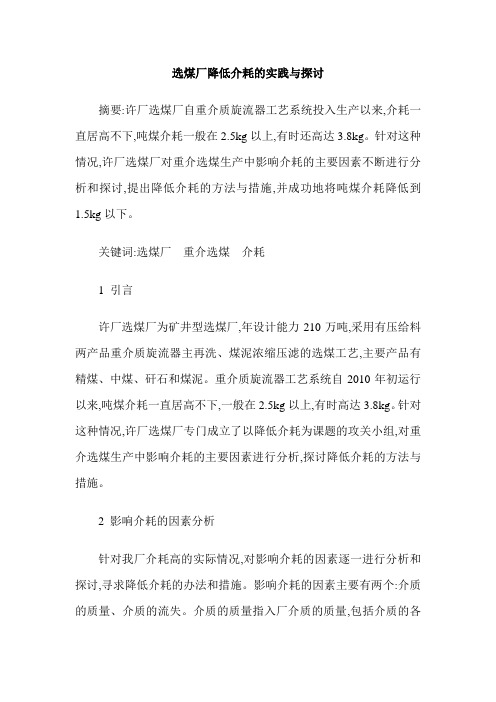
选煤厂降低介耗的实践与探讨摘要:许厂选煤厂自重介质旋流器工艺系统投入生产以来,介耗一直居高不下,吨煤介耗一般在2.5kg以上,有时还高达3.8kg。
针对这种情况,许厂选煤厂对重介选煤生产中影响介耗的主要因素不断进行分析和探讨,提出降低介耗的方法与措施,并成功地将吨煤介耗降低到1.5kg以下。
关键词:选煤厂重介选煤介耗1 引言许厂选煤厂为矿井型选煤厂,年设计能力210万吨,采用有压给料两产品重介质旋流器主再洗、煤泥浓缩压滤的选煤工艺,主要产品有精煤、中煤、矸石和煤泥。
重介质旋流器工艺系统自2010年初运行以来,吨煤介耗一直居高不下,一般在2.5kg以上,有时高达3.8kg。
针对这种情况,许厂选煤厂专门成立了以降低介耗为课题的攻关小组,对重介选煤生产中影响介耗的主要因素进行分析,探讨降低介耗的方法与措施。
2 影响介耗的因素分析针对我厂介耗高的实际情况,对影响介耗的因素逐一进行分析和探讨,寻求降低介耗的办法和措施。
影响介耗的因素主要有两个:介质的质量、介质的流失。
介质的质量指入厂介质的质量,包括介质的各项指标;介质的流失包括跑、冒、滴、漏和事故放料、储运等环节的流失介质,最终产品带介和磁选尾矿中介质流失。
3 降低介耗的方法和措施3.1 加强管理制定行之有效的介耗管理规章制度,不放过影响介耗的每一个环节和细节。
加强员工素质和岗位技能教育,让员工熟悉和掌握选煤工艺过程,了解介耗的因素,熟悉和掌握常用的减少介质损耗的方法。
建立健全非常规介质损耗应急处理预案,并组织培训和学习,以防特大介质损耗事故的发生。
强化介质添加的管理,如实记录加介时间和数量。
月底对各班介耗情况进行统计分析和考核,并与奖金挂钩。
加强维修管理,严格落实包机责任制,加强介质管路及溜槽的保养和维修维护工作,严格控制跑、冒、滴、漏,事故放料等造成介质损耗的环节。
3.2 严把入厂介质质量关及时对每批入厂的介质(磁铁矿粉)进行质量检查。
化验介质的“水份、磁性物含量、粒度组成、真密度”等相关指标,严把介质质量关,各项指标达到要求方可接收。
影响选煤厂介耗的几点因素分析

影响选煤厂介耗的几点因素分析第一篇:影响选煤厂介耗的几点因素分析影响选煤厂介耗的几点因素分析前言在重介质选煤过程中,磁铁矿粉的吨煤损耗量是重介质洗煤厂的一项主要技术经济指标,也是目前选煤厂节能降耗的重点之一。
我国选煤厂设计规范中规定,重介质选煤过程中,吨原煤的介质损耗指标是:块煤系统为0.2~0.3kg,末煤系统为0.5~1.0k g。
事实上,我国选煤厂极少有能达到上述指标的。
目前,吨原煤介质损耗较先进的指标在1.5kg左右,一般在2~3kg,高的在5~6kg。
选煤厂介质损耗高时,一方面可能是因煤质变化较大而使原设计的系统不相匹配;另一方面可能是生产管理问题,这就需要在生产中进行有效管理,减少管理损失,控制技术损失。
下面我结合我矿洗煤厂现状就目前洗煤厂影响介质消耗的几点因素做出分析请领导审阅:1.我矿洗煤厂介耗现状我矿洗煤厂为重介洗煤厂,目前吨原煤介质消耗平均在5 kg,有时甚至更高,但这在较增设TBS前(7~8kg/t)有了很大程度的提高。
介质消耗居高不下是摆在我矿洗煤厂面前的一大难题。
2.影响我矿洗煤厂介耗的因素分析1)磁铁矿粉质量管理。
我矿洗煤厂用作加重质的磁铁矿粉,真密度为4.5g/cm3,磁性物含量为98.9%(刚做过检测)符合重介洗煤厂对磁铁矿粉的要求,但水分含量相对较高为16.5%(中国神华神东煤炭集团洗选中心对磁铁矿粉水分的考核指标为≤8%)。
磁铁矿粉水分对介耗也是有影响的。
案例:神东煤炭集团补连塔洗煤厂采用抓斗机直接将介质加于合介桶,如果水分高,会使介质结团成块,不仅造成加介困难,而且,介质进入悬浮液中难于分散,造成悬浮液不稳定,集控中心显示的合介桶磁性物含量会相对较低,即配置相同密度的重介质磁铁矿粉水分越大所需要的磁铁矿粉越多。
特别是在冬天,介质送来时经过较远的路程,如果水分太大,磁铁矿粉会冻结成块,影响更大。
2)生产技术管理。
①我矿洗煤厂在增设TBS后小时入洗量明显增加,但其它设备并没有相应的扩能,生产能力适应不了目前的上煤量造成介质的损失。
- 1、下载文档前请自行甄别文档内容的完整性,平台不提供额外的编辑、内容补充、找答案等附加服务。
- 2、"仅部分预览"的文档,不可在线预览部分如存在完整性等问题,可反馈申请退款(可完整预览的文档不适用该条件!)。
- 3、如文档侵犯您的权益,请联系客服反馈,我们会尽快为您处理(人工客服工作时间:9:00-18:30)。
专业英文翻译中国矿业大学毕业设计英语翻译姓名:学号:学院:应用技术学院专业:矿物加工工程翻译题目:选煤厂介耗分析指导教师:职称:讲师英文原文An analysis of medium losses in coal washing plants AbstractA major operating cost in dense-medium separation is in replacement of lost medium solids. The loss of medium solids, being costly, plays a crucial role in determining the economics of any preparation operation. Coal washeries that employ dense-medium cyclones often attempt optimization of the processes by varying the vortex or the spigot diameter and the feed relative density. While these changes help in closer control of the separation process, they also result in medium losses due to changes in the medium split ratio (ratio of the medium flow rate in overflow to underflow). Since medium solids are lost by adhesion to products and as magnetic separator effluent, the effect of the change in medium split ratio on the drain-and-rinse screens and, hence, the magnetic separator circuit needs to be studied. In Tata Steel's coal washeries, at Jharkhand India, which employs primary and secondary dense-medium cyclones in series to produce clean coal, middlings and rejects, reducing the relative density of feed medium, had an insignificant effect on the medium split ratio. On the other hand, changing the cone ratio (ratio of the overflow diameter to the underflow diameter) changed the relative density and the flow rates through the cyclone outlets, thus affecting the performance of the magnetite recovery circuit.A systematic study through laboratory tests and a detailed plant sampling campaign helped in identifying the causes of magnetite loss. Upon implementation of the recommendations, the magnetite losses decreased, resulting in a saving of approximately US$27,500 per annum. The study also helped in evolving some checkpoints for plant operators for identifying magnetite losses.Keywords: dense-medium cyclone; magnetite losses; drain-and-rinse screens; magnetic separators1. IntroductionDense-medium (magnetite in the case of coal), a slurry/suspension having a relative density intermediate to that of valuable mineral and gangue, is generally used as the medium of separation in most coal preparation plants. The medium, being costly, plays a crucial role in determining the economics of any preparation operation. Dardis (1987) quotes figures of20–40% of dense-medium plant operating cost being attributable to medium loss for plants engaged in mineral separations employing ferrosilicon as the medium. The figure is 10–20% in the case of magnetite. T here are clearly incentives to reduce this loss, and it is often possible to do so with minimal capital expenditure through improved operating procedures and minor changes to plant configuration. This paper draws on the experience from one such study carried out by R&D Tata Steel, Jamshedpur, Jharkhand, India to identify some important operating issues in medium loss in coal washing plants and the factors influencing the loss.2. Causes of medium loss in dense-medium plantsThere are normally only two possible routes by which medium can be lost from the plant:• adhered to the products of sep aration, after draining and washing on screens; and• present in the final effluent from the medium regeneration process, usually magnetic separators, settling cones or other solid–liquid separation devices.The causes of loss from these sources are as follows:• forces of attraction between the ore and medium particles, ore porosity, and inefficient washing;• magnetic separation and classification inefficiencies;• corrosion and abrasion of the medium, reported for ferro-silicon medium;• excessive circu it loadings during the addition of fresh medium;• housekeeping (when the floors are being cleaned and washed off);• plant downtime (associated with housekeeping);• medium properties (size, shape, magnetic susceptibility).There has been much work done over the years, usually by operating plants, to identify and quantify the sources of medium loss and to minimize consumption. The task, however, is complicated by the difficulty of determining an unequivocal medium balance across the plant by sampling process streams. It is rare that a balance thus established, for a relatively short operating duration, reflects quantitatively the actual consumption recorded by the plant over normal reporting periods such as a month or a year.2.1. Factors affecting losses through drain-and-rinse screensNapier-Munn et al. (1995), during their investigations of the iron ore washing plants at Mount Newman and Tom Price, found that adhesion loss increases with screen loading. The effect was quite strong, and even moderately loaded screens showed a significant increase in loss (expressed in g/t/m of screen width) over lightly loaded screens.An increase in operating relative density also led to significant increases in losses. Most of the increase in loss was attributed to the poor drainage characteristics of the higher viscosity medium (Kittel et al., 1987). A small increase in relative density led to a large increase in viscosity and thus poorer drainage characteristics.The washing arrangement was also found to affect medium losses significantly through drain-and-rinse screens. Of the various washing arrangements, screens with weirs and a vigorous tumbling action reduced the magnetite losses considerably compared to slotted spray bars and screens with flood boxes.2.2. Losses through the magnetic separatorsThere is no consensus in the literature as to the contribution which magnetic separator losses make to total medium loss in dense-medium plants. Dardis (1987), for example, claims thatmagnetic separators account for more than 75% of losses, whereas Mulder (1985) attributes only 18% to this source for the Sishen iron ore dense-medium cyclones. Kittel et al. (1987) reported magnetic separator losses between 2.4% and 24% of the total for the Mt. Newmandense-medium cyclone plant. However, on occasions, when very high viscosity media were used, substantial elevation of the adhesion losses was observed.Adhesion to coal and the losses in the magnetic separator are the two main routes through which magnetite gets lost in a coal washing plant. In general, magnetic separators seem to contribute 20–40% of this loss, though this proportion will fall where adhesion losses are abnormally high, for example, with porous ores. Magnetic separators are therefore an important, though, not necessarily, a dominant source of medium loss. Since their performance can deteriorate markedly if not operated correctly or properly maintained, they deserve close attention.Analysis of losses in magnetic separators collected in plant surveys by Rayner (1994) suggests that this could be due to the separator being overloaded, in terms of either its volumetric capacity or, less often, its dry solids capacity. Hawker (1971) and Sealy and Howell (1977) gave loading limits in terms of dry solids feed rate of magnetics and volumetric flow rate of feed slurry, which could not be exceeded without loss of performance.Dardis (1987) confirmed that the operating variables, which affect magnetic separator performance, include pulp height, magnet position (angle), separation and discharge zone gaps, drum speed, and magnetics to non-magnetics ratio. Lantto (1977), writing from the perspectiveof a hard rock ilmenite concentrator, explained that the recovery in a magnetic separator was feed quality dependent. He also gave recommendations for various separator parameters.Based on operating experience at the Iscor iron ore mines, De Villiers (1983) observed that overloading of the magnetic separators was the main cause of magnetic losses. He also gave the separator settings used at the Iscor plants.3. Investigations at Tata Steel's coal washeriesTata Steel at Jamshedpur, Jharkhand, India owns captive coal washeries, which supply 60% of coking coal requirements for its integrated steelmaking operations. In the washeries, the ROM coal after being crushed and screened at 0.5 mm, the + 0.5 mm fraction is treated indense-medium cyclones (called the coarse circuit) and the − 0.5 mm in a flotation circuit (called the fines circuit). The + 0.5 mm coal is fed to the primary cyclones, which produce clean coal at a lower relative density of separation (1.3–1.5). The underflow from the primary cyclones form the feed to the secondary cyclones which in turn produce middlings and rejects at a higher relative density of separation (1.6–1.9). The magnetite recovery circuit is a typical circuit that exists in any coal washing plant and is shown in Fig. 1.Fig. 1. Schematic medium recovery circuit and the sampling points.The dense-medium and clean coal (middlings or rejects, as the case may be) is laundered to sieve bends and one set of drain-and-rinse screens. The sieve bends and the first section of each drain-and-rinse screen are used to drain medium from the coal; the medium is collected in screenunder-pans and returned to the primary cyclone sump via the primary cyclone medium distribution box. The second section of the screens is used to rinse and drain the coal free of adhering medium. The spray water containing the dense-medium rinsed from the coal is collected in the second section of the screen under-pans and returned to the dilute medium sump for subsequent magnetite recovery. The level of magnetite water slurry in the dilute medium sump can be adjusted using the PID (Proportional, Integral, Derivative 3-term controller) loop provided for level control and the modulating splitter actuator. When the slurry levels in the sump rises, the splitter actuator would divert the flow away from the system to maintain balance. The indication loop also generates high and low alarm levels within the control system.The dilute medium thus collected in the dilute medium sump is pumped to magnetic separators, which produce the recovered magnetite as over-dense medium and a reject tailings circuit. The over-dense medium is returned to the over-dense medium sump and distributed to the dense-medium washing circuits as make up. Magnetic separator tailings are used as product rinsing water.Considering the overall economics of steel-making, it was thought to reduce the composite clean coal ash at the washeries from 17% to 16% starting April 2003. With a view to achieving 16% clean coal ash, the following changes were made in the coal washing plants:(a) The relative density of medium in the primary cyclone circuit was reduced from 1.36 to1.3–1.33(b) The spigot diameter of the secondary cyclones was reduced from 140 mm to 125 mm.These changes would have an effect on the medium split ratio (ratio of the medium flow rate in overflow to underflow) and hence an effect on magnetite recovery.3.1. Effect of reduction of primary relative density on the magnetite recovery circuitHe and Laskowski (1995) studied the changes in medium split ratio by changing the vortex finder diameter and spigot diameter and cyclone inlet pressure at two different medium densities.A total of 27 different vortex finders versus spigot diameter combinations were studied. The tests were carried out with four different magnetite compositions. The studies showed that at a fixed inlet pressure, the relationship between medium split ratio and cone ratio was independent of medium properties. Extending the argument to the change in medium relative density in the primary circuit, it was concluded that there would be no change in medium split ratio due to the reduction in relative density from 1.36 to 1.3–1.33, and hence negligible effect on the medium losses.3.2. Effect of reducing the spigot diameter in the secondary circuitReducing the spigot diameter of the cyclones would indirectly increase the cone ratio, i.e., the ratio of the diameter of vortex finder to the spigot thus affecting the medium split. The flow rate of medium through the overflow would increase and that through the underflow decrease, thus increasing the overall medium split.Changes in the cone ratio would result in either lower/higher pulp relative density and higher/lower flow rates through the cyclone outlets. Lower pulp relative density will have a negligible effect on the performance of the drain-and-rinse screens. However, lower pulp relative density in the feed to the magnetic separator will inhibit the formation of flocs, which has beenidentified as the main process step for magnetic separation. According to the “conceptual collection mechanism” model developed by Rayner and Napier-Munn (2000), magnetic separation proceeds through the rapid formation of magnetic flocs or stringers as soon as the feed slurry is exposed to the magnetic field. Size per se of the magnetite particles is not involved in this process, although magnetic susceptibility is. A substantial proportion of the magnetic solids present will become part of these flocs. The residual magnetic solids are scavenged from the slurry during its passage through the collection zone of the separator. This scavenging occurs by solitary particles joining existing flocs, and is therefore a first order rate process relative to the concentration of residual magnetic particles. At low pulp relative density, the rate of flocculation is too slow for useful flocs to form, and thus capture is effectively a single particle process. This causes a distinct disadvantage to small particles, which may be preferentially lost.Similarly higher pulp relative density would increase the viscosity of the medium coming out through the outlets of the dense-medium cyclone. This in turn would reduce drainage through the drain screens and increase adherence of the medium to the coal samples. This increased adherence of magnetite to coal would directly increase the magnetite loss after rinsing.Within the capacity of the screens, increase/decrease in medium flow rate would not affect the performance of the drain-and-rinse screens. However, increased medium flow rate to the magnetic separator would reduce the residence time and hence the recovery of magnetics.Decreased/increased medium flow rate to the magnetic separator would also affect its performance. The pool depth in the magnetic separator needs to be maintained at an optimum for an efficient magnetic separation. This can be done by adjusting the tailings discharge in the magnetic separator.4. ExperimentationDetailed sampling campaigns were carried out in the magnetite recovery circuit. Samples of clean coal, middlings and rejects, and overflow, underflow and feed to the primary magnetic separator and one secondary separator were collected. These samples were collected in fifteen increments over a period of about 1 min using standard samplers. Each sample was collected from all parts of each flow stream, and all material in the stream had the same probability of being collected. About 15 kg of tailings and 1 kg of concentrate were collected over a period of 1 min by this system. Both wet and dry sample weights were measured using appropriate laboratory techniques (Rayner, 1999), and the relative density of the slurry (weight/volume of the slurry) and the solids concentration were calculated. The magnetic fraction of the concentrate and tailings sample was recovered using the Davis Tube. The data were collected for a month, taking care to avoid sampling when there were abnormal operations in the plant. These data allowed the calculation of concentrate solids content and of magnetics recovery for each trial.The major operating variables of a medium recovery screen that influence its performance are (i) the adhesion of the medium prior to washing, (ii) quantity of wash water, (iii) screen-ore conveying velocity, (iv) screen-ore bed depth, (v) screening duration, (vi) ore size, (vii) ore porosity and (viii) properties of the medium pulp. For any washing plant, the ore size remains constant, and the rank of coal treated also remains unchanged. Hence the factors that were considered for the laboratory study were the adhesion of the medium prior to washing, the time of washing, screening velocity, relative density of medium and the quantity of wash water. The levels of the variables maintained were similar to that in the plant. The tests were carried out with the clean coal (considered as coal type 1) and rejects (considered as coal type 2) obtained from the washery. The wash water and the coal type were varied at two levels and all the othervariables at three levels. All together 108 tests were carried out, the results of which are shown in Table 1.Table 1.Results of simulation of drain-and-rinse screen tests carried out in the labFigures show percentage of magnetite lost after rinsing.The levels of the variables are coded and mentioned as 1, 2 and 3. “Wash water 1” is the quantity of wash water which was coded as level 1, etc.A simple test procedure was adopted to simulate the drain-and-rinse screen section of the medium recovery circuit in the laboratory. Media with three different relative densities were manually prepared using magnetite (size: 90%, − 0.045 mm and 90% magnetics) collected from the washery. The coal had a size range of − 13 +0.5 mm, and 50 g of sample was taken for each test.In this work, the experimental procedure was to initially contact the ore with the medium so as to allow the medium adhesion to occur. The ore to be contacted was placed inside a wire basket and lowered into the re-circulating medium for about 30 s and then taken out. The 30-s contact time is much more than the normal 4–5 s contact time observed in a cyclone.The contacted ore was then taken out of the wire basket and placed on a laboratory screen mounted on a sieve shaker to simulate the medium recovery step across a vibrating medium recovery screen. The sieve shaker was operated without wash water for 15 s to allow the excess medium to drain free from the ore. A sample of the drained ore was taken to determine the mass of the medium adhering to the ore prior to the washing step. The sample was then taken in an open bucket filled with water, the volume being twice that of the sample. The sample with water was then mixed using an impeller for about 2 min. The sample was then taken out, dried, and weighed. The adhered medium from the sample was thus recovered from the ore by scrubbing the ore.The rest of the ore on the screen was further shaken for about 5–15 s with wash water to wash off the adhered medium. Particles that were still adhered to the ore after the washing step were recovered from the ore by scrubbing, as mentioned above.The tests were carried out using statistical design of experiments and the results analysed using the analysis of variance (ANOVA) technique. The variables were studied at different levels, and the percentage of magnetite lost was calculated for each test. The sum of squares, the mean sum of squares, the ‘F’ ratio and the ‘p’ values were calculated. Those variables having a ‘p’ value of more than 0.05 were taken as significant factors.中文译文选煤厂介耗分析摘要在重介质分选中主要的操作损失是介耗。
